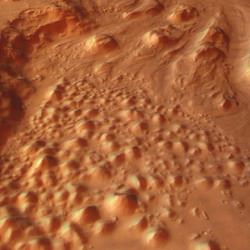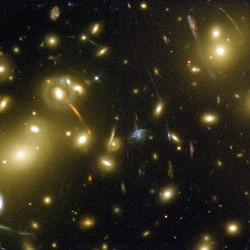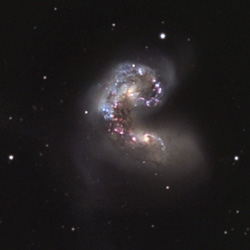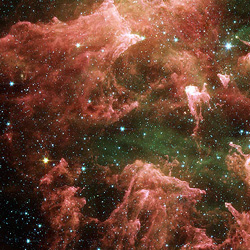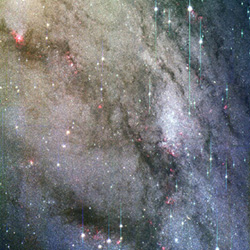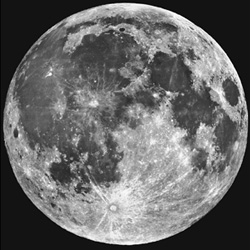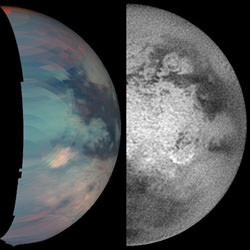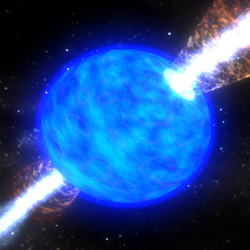
Artist illustration of a gamma-ray burst. Image credit: NASA. Click to enlarge.
Observations by two of the world’s largest telescopes provide strong evidence that a peculiar type of exploding star may be the origin of elusive gamma-ray bursts that have puzzled scientists for more than 30 years.
A team of astronomers from Italy, Japan, Germany and the United States, including the University of California, Berkeley, conclude from observations with the Keck and Subaru telescopes in Hawaii that naked carbon/oxygen stars that flatten as they collapse into a black hole are good candidates for the source of gamma-ray bursts.
Though astronomers have observed a couple of bursts associated with this type of supernova – a Type Ic supernova sometimes called a hypernova – the theory of how a hypernova produces gamma rays is still speculative. The new observations, though not a smoking gun, provide a major piece of evidence that the theory, called the collapsar model, is correct. The model explains how an asymmetric exploding star produces a tight beam of matter and energy out of each pole that generates an intense burst of gamma rays, while the absence of a hydrogen and helium envelope would allow the blast to escape.
“It appears that to produce a gamma-ray burst, a core-collapse supernova needs to be both asymmetric in its explosion mechanism, so that there is a natural axis along which matter can more easily squirt, and free of a hydrogen envelope, so that the jet doesn’t have to pummel through a lot of material,” said co-author Alex Filippenko, UC Berkeley professor of astronomy.
The team, led by Paolo Mazzali of the Trieste Observatory in Italy and the Max-Planck Institute for Astrophysics in Garching, Germany, reported its findings in a paper appearing in the May 27 issue of Science.
The fact that a gamma-ray burst was not observed in association with this supernova is actually in accord with predictions, said UC Berkeley graduate student Ryan Foley, a member of the team.
“These observations suggest that the collapsar model is probably correct and that some of these Type Ic supernovae appear to be off-axis gamma-ray bursts, in which the gamma-ray burst is pointing in some direction other than Earth,” Foley said.
Gamma-ray bursts are brief but bright flashes of X-rays and gamma rays that seem to go off randomly in the sky about once a day, briefly outshining the sun a million trillion times. It took until 1997 to establish that they originate outside our Milky Way Galaxy, and only within the past few years have astronomers gotten tantalizing hints that the bursts are associated with supernovae.
Because they are so bright, gamma-ray bursts have to be a collimated beam, similar to but tighter than the cone of light emitted by a lighthouse. Otherwise, the energy in the explosion would be equivalent to instantaneously converting the mass of several suns into a fireball of energy.
The most popular scenario is that a collapsing star generates two highly collimated beams or jets of particles and energy that flash outward from the poles. The particles and energy generate a shock wave when they hit gas and dust around the star, which in turn accelerates particles to energies at which they emit high-energy light: gamma rays and X-rays. The initial burst fades over a few seconds, but the resulting shock waves (the “afterglow”) can be visible to optical, radio and X-ray telescopes for days after the explosion.
A possible candidate for the type of supernova that could produce a gamma-ray burst is the Type Ic supernova. Type Ic supernovae result from massive stars whose winds have shed their outer envelopes of hydrogen and often all their helium, or that have lost these outer layers to a binary companion. Only the core is left, composed of the elements produced by fusion in the star’s center – mostly carbon and oxygen but other heavy elements as well, down to a solid iron center.
The collapsar theory proposes that the solid iron sphere at the very core of the star collapses under gravity to a black hole, but that the split-second collapse takes place in a unique way. As the iron and surrounding matter fall inward, the spin of the core increases, flattening the in-falling material into a disk that flows inward along the equator. The congestion of in-falling matter pushes some of it right back out along the path of least resistance – the two blowholes at either pole.
The matter shot out from the poles rams into the other layers of the star, which it may not be able to penetrate. The lack of a hydrogen and helium envelope presumably increases the chances the jet will punch through.
“It has so much energy that it pushes through these outer layers of the star, which are of relatively small density compared to the disk of in-falling material in the center of the star,” said Foley. “Eventually, if it punches out, you have a gamma-ray jet. Some Type Ic supernovae may be failed gamma-ray bursts, which means the jet tried to push out, but there was too much material in the way, and it never actually broke out. That would explain why we don’t see gamma-ray bursts associated with some of these objects.”
If the theory is true, astronomers should see different things depending on whether the jet is aimed toward Earth or away from it. If the jet is coming out perpendicular to our line of sight, for example, no gamma-ray burst would be visible, but other aspects of the expanding supernova blast wave should be observable. In particular, the spectrum of the supernova a year or so after its explosion should show emission lines of elements, such as oxygen, that are split, one shifted slightly to lower wavelengths and the other shifted to higher wavelengths. The two lines would come from opposite sides of the expanding disk around the equatorial region of the remnant black hole, one Doppler shifted toward the red because it is moving away from us, the other blueshifted because it is moving toward us. Such split or double lines would not be visible from a polar perspective.
About two years ago, on Oct. 25, 2003, UC Berkeley researchers had discovered a Type Ic supernova using Filippenko’s automated supernova search telescope, the Katzman Automatic Imaging Telescope (KAIT) at the University of California’s Lick Observatory. Called SN 2003jd, the supernova was about 260 million light years away in the constellation Aquarius. Though no associated gamma-ray burst was recorded, the supernova appeared to be as bright as the supernovae previously associated with gamma-ray bursts, so the international team reporting this week in Science decided to look again at the supernova, taking its spectrum in search of double-peaked emission lines.
“These observations were actually guided by our theoretical predictions,” Mazzali said. “The idea was that a bright Type Ic supernova, not accompanied by a gamma-ray burst, could be just what we were looking for: an off-axis event which could confirm our predictions.”
Koji Kawabata from Hiroshima University, Ken’ichi Nomoto of the University of Tokyo and his colleagues observed the remnant nebula with the 8.2-meter Subaru telescope on Sept. 12, 2004, about 330 days after it blew. Subsequently, Filippenko and Foley turned the 10-meter Keck telescope on the nebula on Oct. 19, 2004, about 370 days after the initial explosion, to obtain spectral images with the Low Resolution Imaging Spectrometer (LRIS). Both telescopes sit atop Mauna Kea volcano on the island of Hawaii. Subaru is operated by the National Astronomical Observatory of Japan, while the Keck Observatory is operated by the California Association for Research in Astronomy, whose board of directors includes representatives from the California Institute of Technology (Caltech) and UC.
Kawabata, Mazzali and his team analyzed the spectra, revealing that they exhibit split oxygen and magnesium emission lines exactly as would be expected if the collapsar model of gamma-ray production were correct. This was the first Type Ic supernova to show split oxygen lines.
“Jets are a signature of the model, which means that not all explosions will be pointed directly at us. If every time we looked at these objects they appeared to be pointing at us, that would mean the model is probably flawed,” Foley said. “The model predicts that a certain percentage of these objects should look like this supernova (SN 2003jd). Now that we’ve found one of these, the credibility of the model has increased.”
To see such double oxygen lines, the supernova nebula would have to be viewed within 20 degrees of the expanding disk, a rare situation that could explain why other Type Ic supernovae, including some associated with a gamma-ray burst, do not show the split oxygen line.
“(Our observations) strengthen the connection between gamma-ray bursts and Type Ic supernovae by showing that the Type Ic SN 2003jd appears to indeed have been an asymmetric explosion whose main axis of ejection happened not to be pointing at us,” Filippenko said.
Other coauthors of the paper are Keiichi Maeda, Jinsong Deng and Nozomu Tominaga of the University of Tokyo; Enrico Ramirez-Ruiz of the Institute for Advanced Study in Princeton, New Jersey; Stefano Benetti of the Astronomical Observatory of Padova, Italy; Elena Pian of the Trieste Observatory; Youichi Ohyama of the Subaru Telescope; Masanori Iye of Japan’s National Astronomical Observatory; Thomas Matheson of the National Optical Astronomy Observatory in Tuscon, Ariz.; Lifan Wang of Lawrence Berkeley National Laboratory; and Avishay Gal-Yam of Caltech.
The work was supported in part by the National Science Foundation, the Japan Society for the Promotion of Science and Japan’s Ministry of Education, Culture, Sports, Science and Technology.
Original Source: Berkeley News Release
